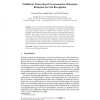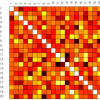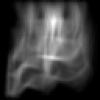111
Voted
ICPR
2006
IEEE
15 years 6 months ago
2006
IEEE
Gait is a useful biometric which can be used to recognize people at a distance when other biometrics are incapable. However, most work on gait recognition has been visible spectru...
95
Voted
ICB
2007
Springer
15 years 6 months ago
2007
Springer
Abstract. Most of gait recognition algorithms involve walking cycle estimation to accomplish signature matching. However, we may be plagued by two cycle-related issues when develop...
105
Voted
ICB
2007
Springer
15 years 6 months ago
2007
Springer
Recent studies have shown that shape cues should dominate gait recognition. This motivates us to perform gait recognition through shape features in 2D human silhouettes. In this pa...
97
Voted
ICIP
2007
IEEE
15 years 7 months ago
2007
IEEE
Gait has received much attention from researchers in the vision field due to its utility in walker identification. One of the key issues in gait recognition is how to extract di...
110
Voted
ICRA
2008
IEEE
15 years 7 months ago
2008
IEEE
— Gait recognition has recently gained attention as an effective approach to identify individuals at a distance from a camera. Most existing gait recognition algorithms assume th...
74
Voted
BLISS
2008
IEEE
15 years 7 months ago
2008
IEEE
This paper reports the preliminary experiments on the cow identification via gait recognition of motion images. The eight cows walking under two different situations have been pr...
125
click to vote
ICB
2009
Springer
15 years 7 months ago
2009
Springer
The small sample size problem and the difficulty in determining the optimal reduced dimension limit the application of subspace learning methods in the gait recognition domain. To...
73
Voted
ICPR
2004
IEEE
16 years 1 months ago
2004
IEEE
We present a robust representation for gait recognition that is compact, easy to construct, and affords efficient matching. Instead of a time series based representation comprisin...
83
Voted
ICPR
2008
IEEE
16 years 1 months ago
2008
IEEE
Many studies have now shown that it is possible to recognize people by the way they walk. As yet there has been little formal study of people recognition using the kinematic-relat...
103
Voted
ICIP
2001
IEEE
16 years 2 months ago
2001
IEEE
We show how the symmetry of motion can be extracted by using the Generalised Symmetry Operator for analysing motion and for gait recognition. This operator, rather than relying on...



